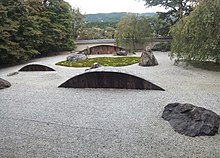Jissō-in
Coordinates: 35 ° 4 ′ 44 ″ N , 135 ° 46 ′ 53 ″ E
The Jissō-in ( Japanese 実 相 院 ) is a Buddhist temple in Iwakura, Sakyō-ku district of the city of Kyoto , Japan .
The temple, which today does not belong to any Buddhist school, was founded in 1229 by the monk Jōki ( 静 基 ), son of the court nobleman Takatsukasa Kanemoto. Originally he belonged to the Tendai School ( Tendai-shū ), which is why the "Immobile King of Light" Acala (Japanese Fudōmyōō , 不 動 明王 ) is still the center of worship. As a temple ( 門 跡 寺院 , monzeki jiin ) reserved for members of the court nobility , the temple also bears the name Iwakura Jissō-in monzeki ( 岩 倉 実 相 院門 跡 ) or, for short, Jissō-in monzeki or Iwakura monzeki . He was initially in Murasakino (now the northern district of the city of Kyoto). During the Ōnin war (1476/77) it was moved to its current location. Large parts of the complex had been destroyed by the end of the Kamakura period .
At the beginning of the Edo period , Ashikaga Gijin ( 足 利 義 尋 ; 1572-1605), a son of the last Shogun of the Muromachi period , took over the management of the temple. The latter's mother was appointed partner of the Tennō Go-Yōzei after the father's death . Thanks to these relationships, the facility was able to be rebuilt with the support of both the imperial court and the Shogun Tokugawa Ieyasu . Numerous components of other, no longer required buildings of the courtyard in Kyoto were used here. All the rulers of the temple came from the family of the Tenno dynasty.
The complex includes a pond garden with stone lamps by the painter Ganku (1756–1839) and a rock garden ( Kare-san-sui ). In the main hall there is a statue of Acala from the Kamakura period. In the temple's collection, some objects are considered to be particularly valuable: a manuscript by Tennō Go-Yōzei ( Important Cultural Property ), further screen pictures by Kanō Eikei ( 狩 野 永 敬 ; 1662–1702), the fourth representative of the Kyoto Kanō- School , as well as the diary of the temple rulers ( Jissō-in nikki ) kept for over 260 years .
Towards the end of the Edo period, the courtier and politician of the late Edo and early Meiji periods Iwakura Tomomi lived here temporarily .
literature
- Makino Osamu: Kyōto no jisha 505 wo aruku (part 1). PHP Shinsho, 2007 ( 槇 野 修 : 京都 の 寺 社 505 を 歩 く 上 ー 洛 東 ・ 洛 北 (東 域) ・ 洛 中 編 )
- Suga Shūji: Kyōto Iwakura Jissō-in nikki - Kakyū kizoku ga mita Bakumatsu . Kōdansha, 2003 ( 管 宗 次 : 京都 岩 倉 実 相 院 日記 ー 下級 貴族 が 見 た 幕末 )
Web links
Remarks
- ↑ Iwakura was a village in the Murasakino district until it was incorporated.

